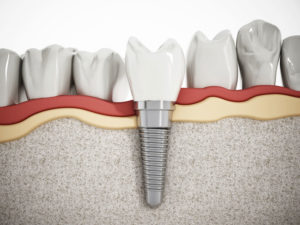How do Crowns Work?
 A crown is used to entirely cover or “cap” a damaged tooth. In other words, a crown acts like an engineered helmet for your tooth. Besides strengthening a damaged tooth, a crown can be used to improve its appearance, shape or alignment. A crown can also be placed on top of an implant to provide a tooth-like shape and structure for function. Porcelain or ceramic crowns can be matched to the color of your natural teeth. Crowns are cemented onto a tooth or an implant and are not able to be removed by you.
A crown is used to entirely cover or “cap” a damaged tooth. In other words, a crown acts like an engineered helmet for your tooth. Besides strengthening a damaged tooth, a crown can be used to improve its appearance, shape or alignment. A crown can also be placed on top of an implant to provide a tooth-like shape and structure for function. Porcelain or ceramic crowns can be matched to the color of your natural teeth. Crowns are cemented onto a tooth or an implant and are not able to be removed by you.
Crowns are recommended to:
- Replace a large filling when there isn’t enough tooth remaining
- Protect a weak tooth from fracturing
- Restore a fractured tooth
- Cover a dental implant
- Cover a discolored or poorly shaped tooth
- Cover a tooth that has had root canal treatment
How do Bridges Work?
A bridge may be recommended if you are missing one or more teeth. Gaps left by missing teeth eventually cause the remaining teeth to rotate or shift into the empty spaces, resulting in a bad bite. The imbalance caused by missing teeth can also lead to gum disease and temporomandibular joint (TMJ) disorders.
Bridges are commonly used to replace one or more missing teeth. They span the space where the teeth are missing. Bridges are cemented to the natural teeth or implants surrounding the empty space. These teeth, called abutments, serve as anchors for the bridge. A replacement tooth, called a pontic, is attached to the crowns that cover the abutments. Bridges are cemented onto a teeth or implants and are not able to be removed by you.
How Long do Crowns and Bridges Last?
While crowns and bridges can last a lifetime, they do sometimes come loose or fall out and even get a cavity. The most important step you can take to ensure the longevity of your crown or bridge is to practice good oral hygiene. A bridge can lose its support if the teeth or bone holding it in place are damaged by dental disease. Keep your gums and teeth healthy by brushing with fluoride toothpaste twice a day and flossing daily. Also see your dentist and hygienist regularly for checkups and professional cleanings.
To prevent damage to your new crown or bridge, avoid chewing hard foods, ice or other hard objects.